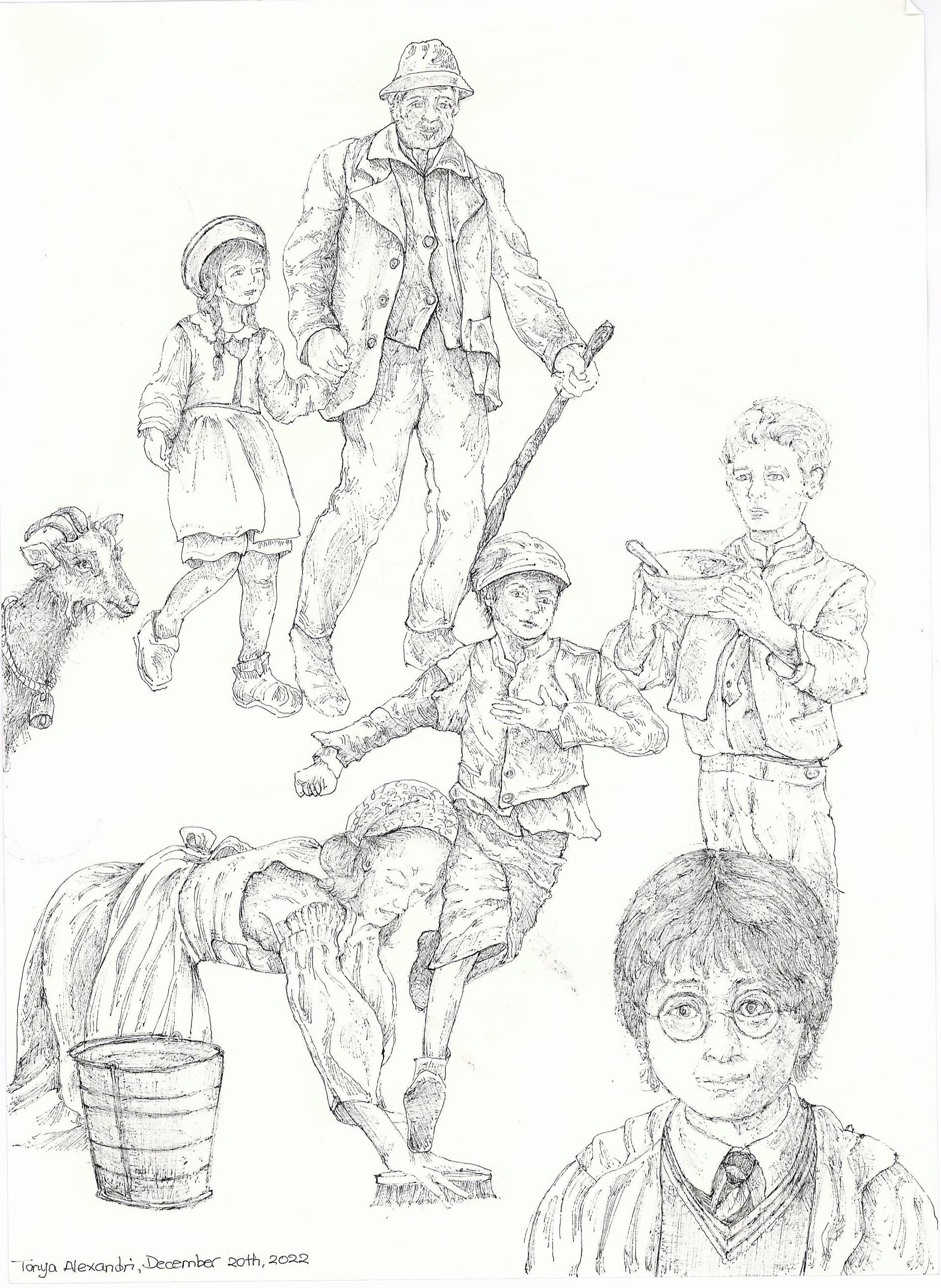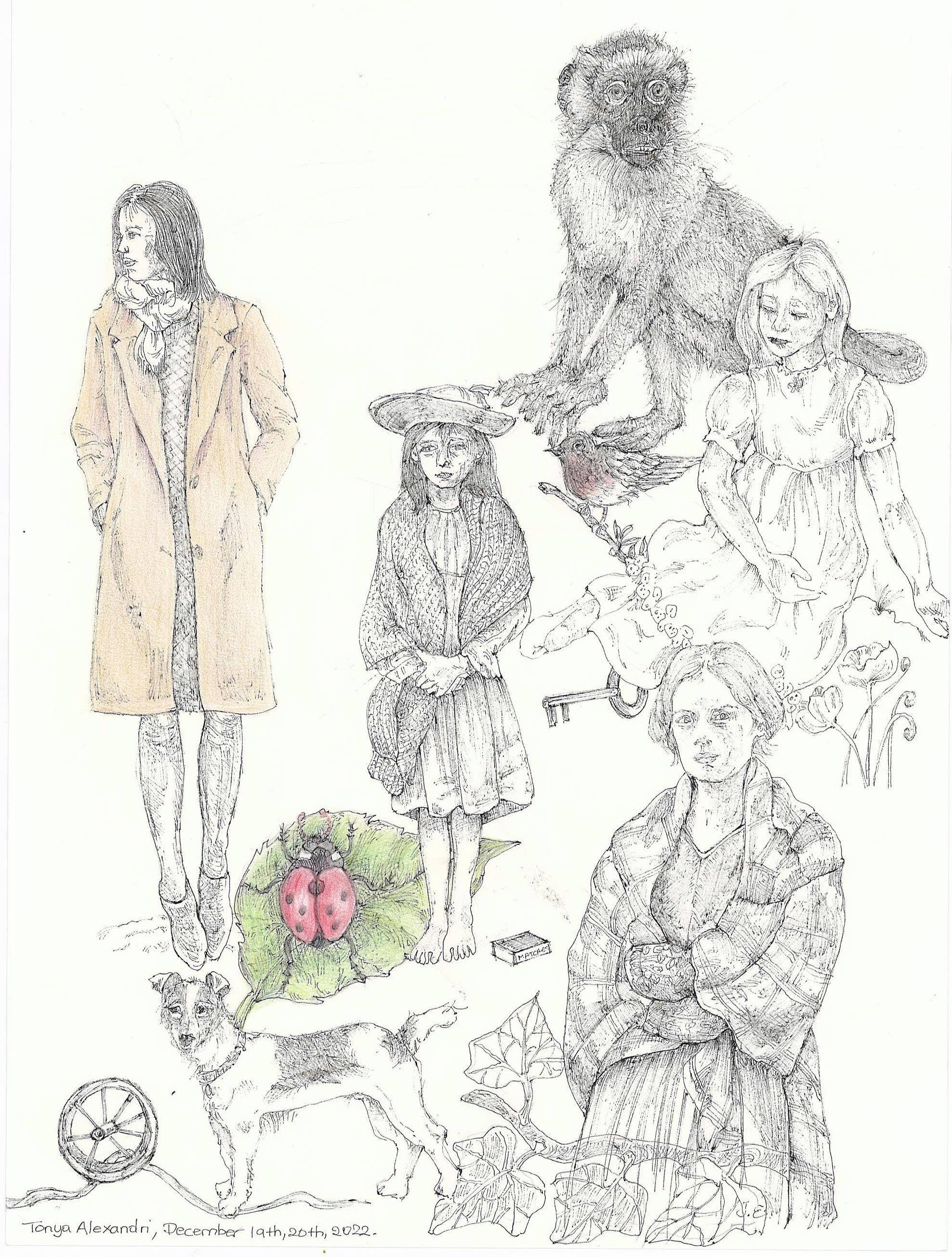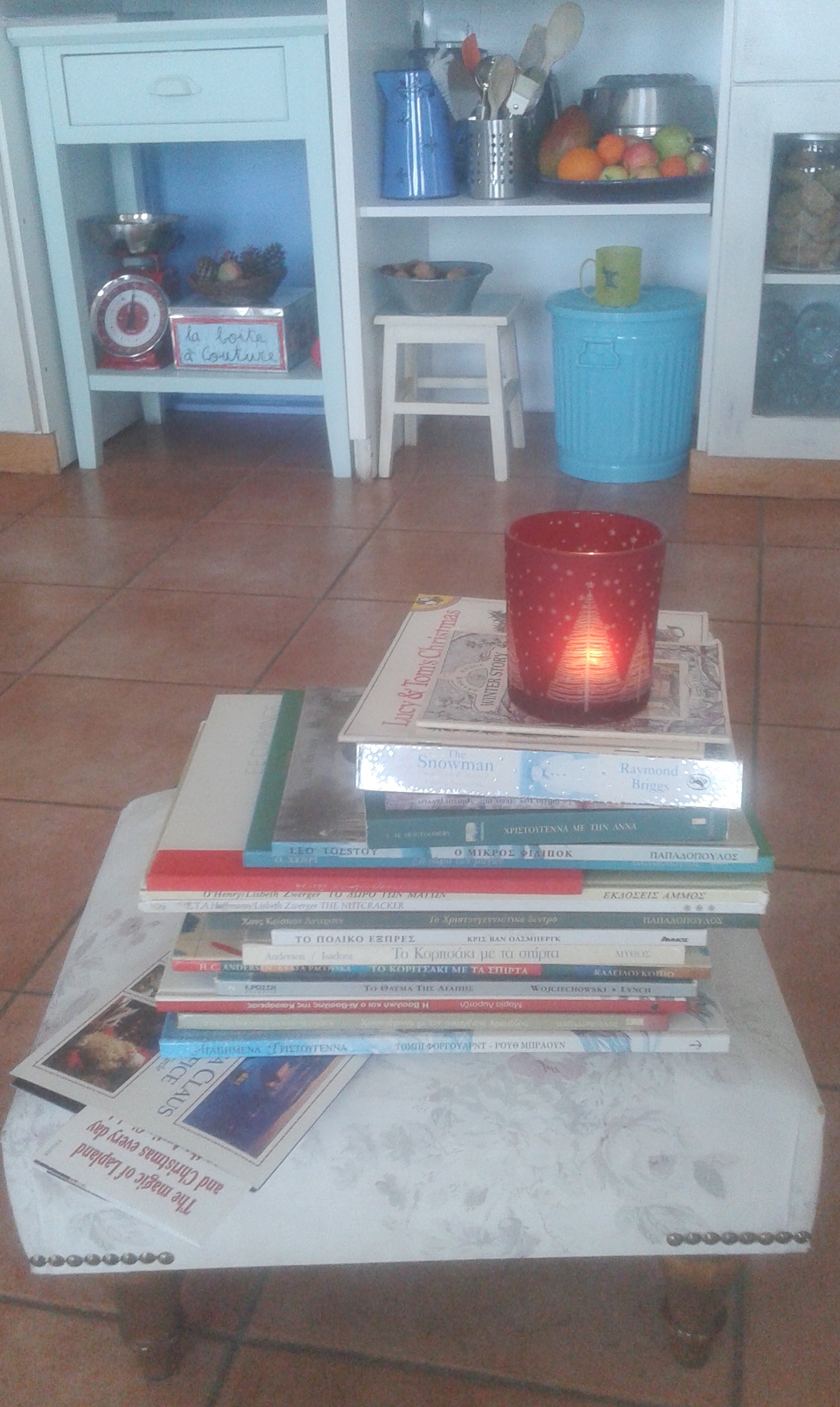Orphan protagonists in literature

“The year end brings no greater pleasure then the opportunity to express to you season’s greetings and good wishes. May your holidays and new year be filled with joy.” Charles Dickens
“What made Sara most popular was this gift for telling stories. When she sat in the middle of a circle of children, and began to invent the most wonderful things, her green eyes shone with excitement….. ‘When I’m telling it, it doesn’t seem made up. I feel as if I am all the people in the story, one after the other!’ “ (From A Little Princess by Francis Hodgson Burnett retold by Joan Collins, Ladybird Books)


As I’ve mentioned I like children’s books and literature. I don’t always find the time to indulge in it, but around the holidays I like to reread Christmas classics and other stories. This year, I decided to listen to stories while doing things around the house and while drawing. I listened to Christmas with Anne by L. M. Montgomery, Oliver Twist by Charles Dickens, The Secret Garden and A Little Princess by Frances Hodgson Burnett, Hans Christian Andersen’s well known tale, The Little Match Girl, and others. I also listened to a story by Fyodor Dostoevsky, The Little Orphan, which I had not read before. It was published in 1887, whereas, Andersen’s story was published in1846.
In Dostoevsky’s story it’s Xmas Eve, but for this little boy it is the day his mother will pass away first and then he himself will die of hunger and cold. In this beautifully written short story Dostoevsky gives us a realistic glimpse of the lives and hardships of the poor in 19th century Russia:
“Several times since morning he has drawn near the bed covered with a straw mattress as thin as gauze, where his mother lies sick, her head resting on a bundle of rags instead of a pillow. How did she come there? She came probably from a strange city and has fallen ill. The proprietress of the miserable lodging was arrested two days ago, and carried to the police station; it is a holiday today, and the other tenants have gone out. However, one of them has remained in bed for the last twenty-four hours, stupid with drink, not having waited for the holiday. From another corner issue the complaints of an old woman of eighty years, laid up with rheumatism. This old woman was formerly a children’s nurse somewhere; now she is dying all alone….”
While in search of some food the boy sees the grandeur of the rich during the season of Christmas through the windows of the houses he passes by. Through the window of the second house he sees that children are being given cake by a woman. He dares to enter the door, but causes much confusion. He is pushed out with a coin for the people there do not want to be reminded of this harsh reality. When the little boy dies he goes to a special place, with a brilliant Christmas tree, that Jesus has made for all the children who have no food or warm shelter and no one to care for them. In the story the little boy is reunited with his mother.
In Andersen’s story the little girl has hallucinations of a warm room and meals and a Christmas tree, and of being reunited with her beloved grandmother in heaven. Like Andersen, Dostoevsky provides a metaphysical happy ending, which reflected religious and spiritual beliefs of hope for those who suffer or have not in this life. They also provide relief for their readers. However, I remember that as a child I always felt distress with the ending of Andersen’s story. I wondered why the writer didn’t provide an ending where human compassion and generosity save the little girl’s life. I wondered why he chose such an “uncertain and unjust happy ending”. Then I imagined my own more down to earth ending to the story. Many decades later as I listened to these stories I found that I still felt that same desire for a different ending.
I also realized that the orphan theme is common, especially in children’s literature from Cinderella to superheroes and Pippi Longstocking, orphans have been the main characters of many of our beloved stories across culltures. There is for instance, The Jungle Book series by Rudyard Kipling about a feral child called Mowgli raised by his wolf parents. The Roman tale of the orphaned twins, Romulus and Remus, suckled by a she-wolf, before they rise to become the founders of Rome, is another earlier story of orphans raised by non human creatures. The orphan Mary in The Secret Garden is sent to live with a detached uncle and young Heidi is sent to live with her Grandfather in the Alps after the deaths of her parents. Peter Pan, who can fly and never grows up, is another orphan created by the Scottish novelist and playwright J.M Barrie. These and many others are all stories that have shaped and fascinated children and adults through time. The orphan theme is common in fairy tales as well. For instance, Rapunzel’s parents are forced to give her up as an infant to an evil witch, who locks her in a tower with no stairs or door where the only way to enter is to climb up her long hair. The story was first published in 1812 as part of a collection of German fairy tales by the Grimm Brothers. Another fairy tale in the 1812 Brothers Grimm collection is Snow White, the tale of a young girl whose mother dies in childbirth and is left with an evil stepmother.
The roots of the orphan hero / heroine in children’s literature go back in time and versions of certain stories have propagated throughout time and across cultural boundaries, and although the stories vary there are some universal cultural elements. In the nineteenth century the orphan hero and heroine rose in prominence in literature. Some have suggested that high mortality rates and poverty made orphans commonplace and this sensitized and attracted many well known writers. Charles Dickens’ books, David Copperfield, Oliver Twist and Great Expectations all tell the story of a poverty-stricken, orphan boy rising through the ranks of society, against all sorts of odds. There are many stories of girl orphans, too. Some of my favourite early readings were Pollyanna, Heidi, Anne of Green Gables, A Little Princess, The Secret Garden and Jane Eyre by Charlotte Bronte, a well known heroine of Victorian literature, who as a young girl was sent to live with relatives after her parents’ death and who later became a governess. Today story tellers like JK Rowling and Lemony Snicket have also produced some well loved series with orphan characters.
So why are both writers and readers attracted to stories of orphans?
In stories orphans often touch our hearts, fill us with compassion, and also, win our admiration for their tenacity, resourcefulness and endurance. They usually go through a lot of hardship before they find the love and belonging they have been seeking. We can all relate to these stories to some extent or other. Orphan characters symbolize vulnerability, isolation or marginalization. Because they have lost their belonging to the most basic social group, such as, a nurturing family, often society or certain cultures marginalize them and treat them as less then. This draws readers into the hero / heroine’s journey and triggers empathy and compassion, as well as, a desire for justice. Also, good stories require wide story arcs. Orphan protagonists often start out low and rise high through overcoming a series of obstacles. Being orphaned is also probably a child’s worst fear. I read a piece by a writer who suggested that her artistic interest in orphan characters may be a relic of that childhood fear.
From a psychological point of view we might relate to these stories because they remind us of or trigger “orphaned aspects” in us that carry our traumas or fear of abandonment, the parts of us that might carry memories of abandonment, neglect or lack or of being left out and not having a sense of true belonging. These stories might also connect us to our fear of knowing that we will all be orphaned sooner or later. They may also trigger our own existential fears of our own mortality. Those of us who are parents might at times have come in touch with an underlying fear of the possibility of not being around long enough to raise our children. Many people might carry some deep even unacknowledged fear around the fulfillment of our basic human needs of survival, safety and belonging that are often more intensely compromised for orphans both in reality and in stories.
From a Jungian perspective one might think of the orphan archetype as the one that has a backstory defined by trauma, abandonment, abuse, or neglect and that is often positioned as an outsider and in search of safe belonging. It might be more developed in those who were orphaned as children, but also in those who were not truly nurtured for who they were. An archetype refers to a set of characteristics, fears, experiences and motivations that are universally recognizable to all readers to one degree or another. The archetype doesn’t necessarily require that a character in a book or film is actually orphaned. It’s more about how the protagonist perceives their own belonging in the world. This inner orphan aspect of our psyche might also be a force propelling us to heal and grow.
In relation to the question of why orphans appear so frequently in 19th-century fiction and the opportunities they provide for authors, Professor of Literature and researcher John Mullan [https://www.bl.uk/romantics-and-victorians/articles/orphans-in-fiction\], writes: “If we look to classic children’s fiction we find a host of orphans….. Their stories can begin because they find themselves without parents, unleashed to discover the world.” He claims that orphans are characters out of place, forced to navigate their way through the trials of life and make their own home. Therefore, orphan characters are free from established conventions to face a world of endless possibilities (and dangers). He writes: “The orphan leads the reader through a maze of experiences, encountering life’s threats and grasping its opportunities. Being the focus of the story’s interest, he or she is a naïve mirror to the qualities of others….. ” Mullan also comments on how along the way and before the often happy ending the hero or heroine will reveal uncomfortable truths about society. As I mentioned above Dostoevsky’s short tale is a commentary on socioeconomic reality of Russia at the time. Mullan writes that Oliver Twist “reveals to the reader the secrets of London’s criminal underbelly” and that “Dickens reflects with savage facetiousness on the mortality rate among orphaned infants doomed to this fate.” Similarly, in Mark Twain’s book as we follow our protagonist’s journey the social issues of racism, child maltreatment, class inequity, access to education, and more, are revealed to us.

He adds that another reason for the frequency of the orphan protagonist is that any author interested in the vulnerability of children is likely to think of orphans. Orphans are dependent on the kindness of others. He refers to the fact that often female orphans in order to survive end up becoming a governess, an occupation which Jane Fairfax, in Jane Austin’s novel Emma considers a kind of slavery. Mullan adds that the governess is also a recurring literary motif and that life as a governess is the fate of Victorian fiction’s most famous female orphan Jane Eyre. He writes: “Mr. Brocklehurst, the self-proclaimed Christian who rules over the school, is malign and, as an orphan, Jane has only her own spirit with which to defend herself. Parentless protagonists like Jane and Jude are frighteningly vulnerable to prejudice and cruelty.” In her novel, Villette, Brontë’s heroine Lucy Snowe also appears to be an orphan, who is forced to survive first as a ‘companion’ to a cantankerous old lady, and then as a junior teacher in a girls’ school in Villette of Brussels, where one of her spoilt students comments: ‘I suppose you are nobody’s daughter’.
Mullan conludes that there is a real social history behind these fictional orphans, and also that orphaning the main characters was fictionally useful because it was a way by which they were made to find their way in the world.
Finally, I’d like to wish everyone much love, joy and peace during the holidays and beyond.
